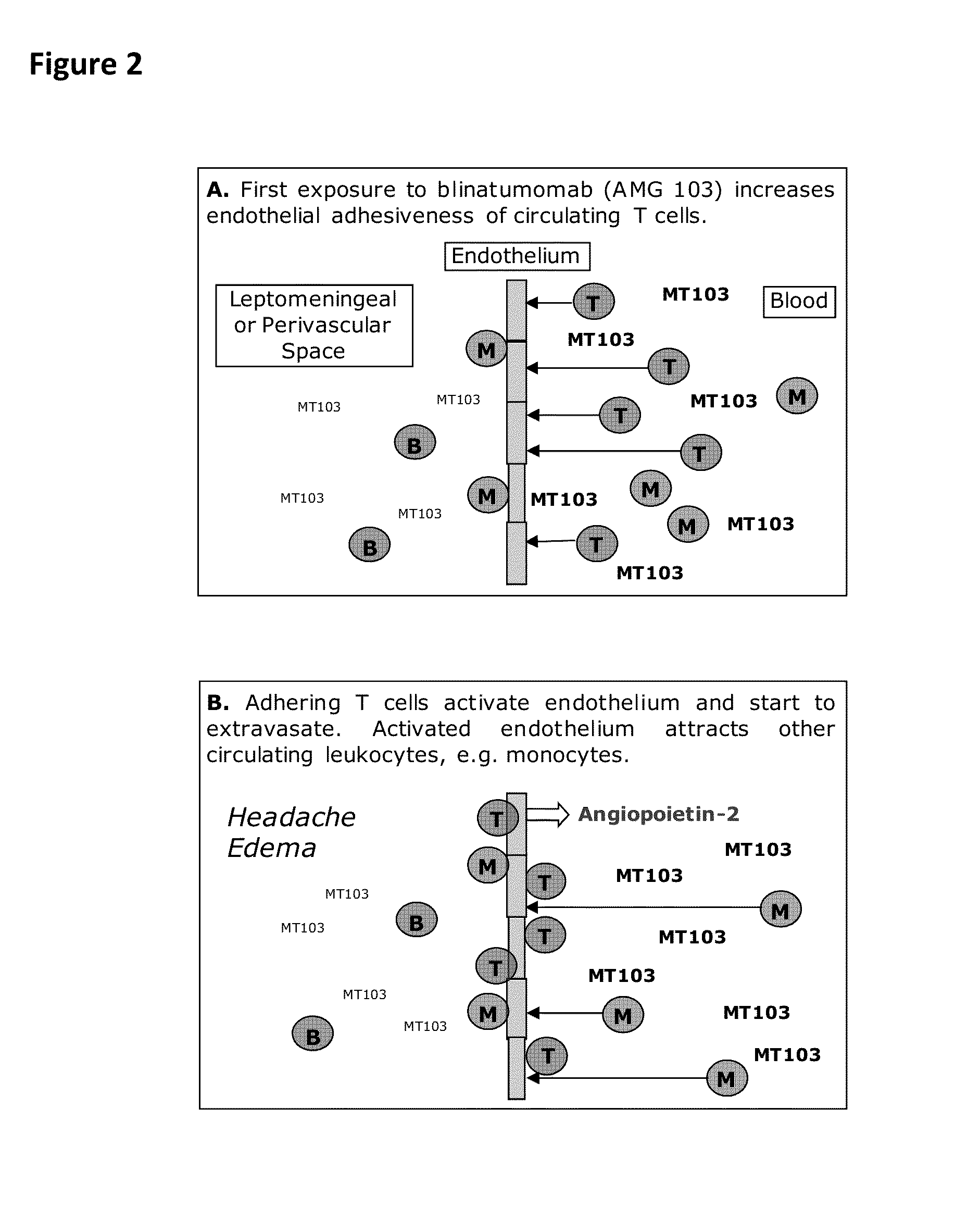Anti-Leukocyte Adhesion for the Mitigation of Potential Adverse Events caused by CD3-Specific Binding Domains
a technology of cd3-specific binding and anti-leukocytes, which is applied in the field of anti-leukocyte adhesion for the mitigation of potential adverse events caused by cd3specific binding domains, can solve the problems of inability to completely cure combination, b cell-malignancy may become refractory, and often remain incurable, so as to improve the prophylactic effect, improve the effect of t cell prophylaxis and/or amelioration
- Summary
- Abstract
- Description
- Claims
- Application Information
AI Technical Summary
Benefits of technology
Problems solved by technology
Method used
Image
Examples
example 1
Successful Mitigation of CNS AEs by Anti-Leukocyte Adhesion with PPS in Patients at High Risk of Discontinuation of Blinatumomab Treatment Due to CNS AEs
Dosing Regimen of Blinatumomab and PPS Co-Medication.
[0252]In a phase 1 clinical study three patients were treated with Blinatumomab at an initial dose of 5 μg / m2 / day for 1 week followed by a dose escalation to 60 μg / m2 / day for additional 3 to 7 weeks. Concomitant PPS was administered as 100 mg bolus iv infusion at 3 h±30 min prior to start of infusion and dose escalation of Blinatumomab followed by perfusion of 300 mg / day for 48 h after start of infusion and dose escalation of Blinatumomab.
Patient 109-036 (See Also FIG. 3E).
[0253]Patient 109-036, a male Caucasian, age 62, weight 96.8 kg, height 178 cm, presented with Follicular Lymphoma grade I / II. Previous therapies included CHOP (02 / 12-03 / 04), Dexa BEAM (03 / 05), Cyclophosphamid (03 / 08), and radio therapy followed by autologous stem cell transplantation (03 / 08). The patient achiev...
example 2
In Vitro Flow Chamber System Mimicking T Cell / Endothelial Cell-Interaction Triggered by Blinatumomab or Other CD3-Specific Binding Drugs
Cultivation of Endothelial Cells.
[0256]Human brain microvascular endothelial cells (HBMEC) (#1000, Sciencell Research Laboratories) or human umbilical vein endothelial cells (HUVEC) (#C-12200, Promocell) were used as endothelial cell-model. Cryopreserved HBMEC at passage 1 (>5×105 cells / ml) were first cultivated in fibronectin-coated Nunclon-treated 75 cm2 cell culture flasks (#156499, Nunc) at 37° C. and 5% CO2 in a Heraeus Cytoperm 2 (Thermo Scientific) according to the manufacturer's instructions. Sub-cultivation of HBMEC was done with the Detach Kit (#C-41200, Promocell) consisting of HEPES-buffered balanced salt solution (#C-40000, Promocell), trypsin-EDTA solution (0.04% / 0.03%) (#C-41000, Promocell) and trypsin neutralization solution (TNS, #C-41100, Promocell). Briefly, the medium was aspirated from the HBMEC-layer and cells were washed with ...
example 3
Doses and Schedules of Co-Medications Following the Principle of Anti-Leukocyte Adhesion for Mitigating CNS AEs
[0295]Administration Schedule for Intravenous PPS Co-Medication with Blinatumomab Treatment for Use in Humans.
[0296]Patients receive a 100 mg bolus injection of PPS 3 h±30 min prior to start of infusion and any dose step of Blinatumomab. Immediately after the bolus injection, intravenous administration of PPS is continued by perfusor at 300 mg / day for 72 h.
[0297]Administration Schedule for Oral PPS Co-Medication with Blinatumomab Treatment For Use in Humans.
[0298]Patients receive 900 mg PPS daily given orally as 300 mg (e.g. 3×100 mg) three times per day starting 7 days before start of infusion and any dose step of Blinatumomab. Oral administration of 900 mg PPS daily is continued for 72 h after start of infusion and any dose step of Blinatumomab.
[0299]Administration Schedule for Intravenous Minocycline Co-Medication with Blinatumomab Treatment for Use in Humans.
[0300]Patie...
PUM
| Property | Measurement | Unit |
|---|---|---|
| Adhesion strength | aaaaa | aaaaa |
Abstract
Description
Claims
Application Information
 Login to View More
Login to View More - R&D
- Intellectual Property
- Life Sciences
- Materials
- Tech Scout
- Unparalleled Data Quality
- Higher Quality Content
- 60% Fewer Hallucinations
Browse by: Latest US Patents, China's latest patents, Technical Efficacy Thesaurus, Application Domain, Technology Topic, Popular Technical Reports.
© 2025 PatSnap. All rights reserved.Legal|Privacy policy|Modern Slavery Act Transparency Statement|Sitemap|About US| Contact US: help@patsnap.com



